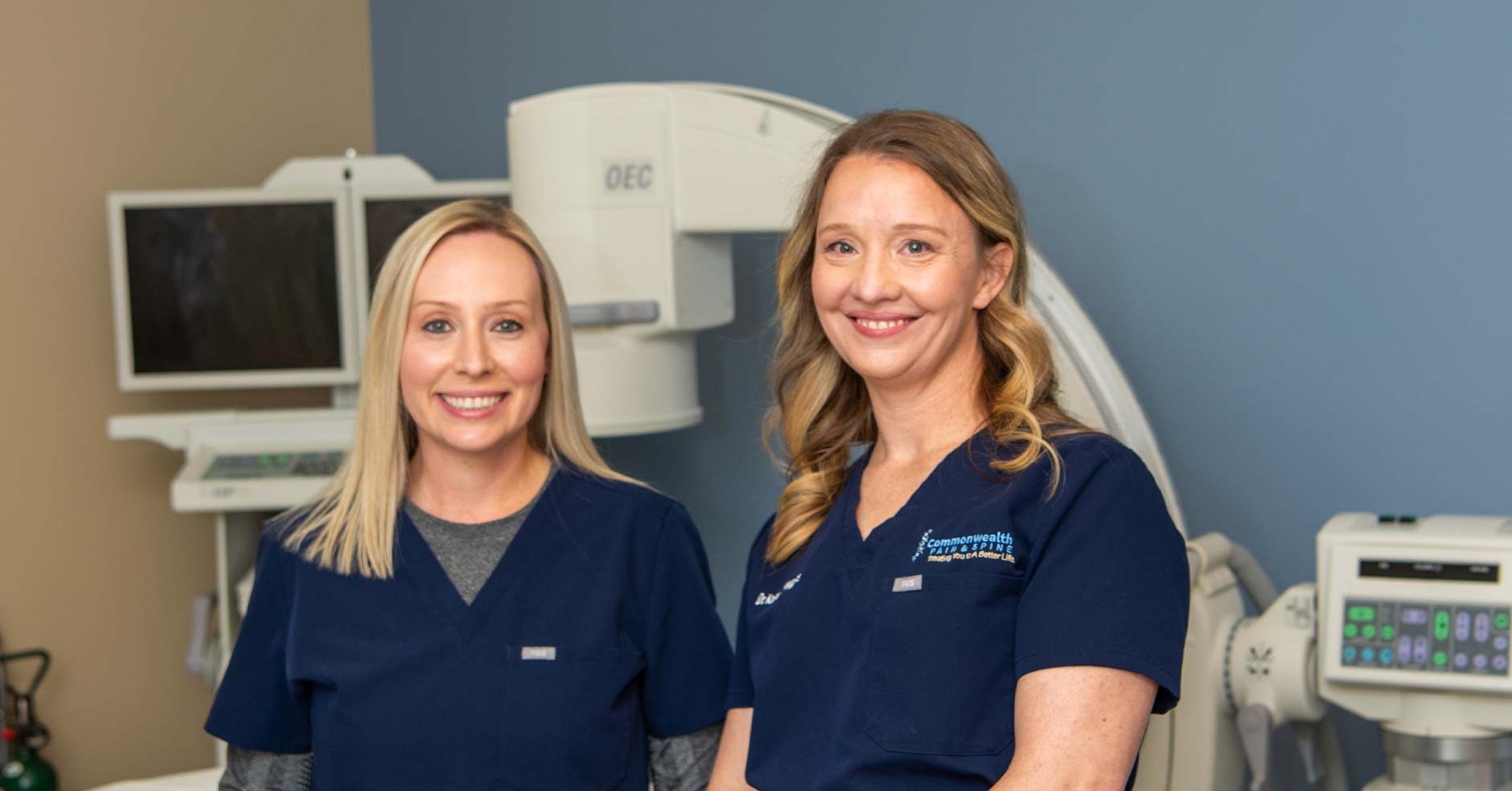By taking an innovative approach to treatment and a progressive position on staffing, Commonwealth Pain & Spine is changing the face of pain management.
LOUISVILLE In the last fifty years, the gender gap among medical practitioners has narrowed tremendously, with female medical students now making up more than 50% of the incoming class. Currently, more than one-third of those in the physician workforce are women. However, in some specialties there is still a significant amount of gender disparity. Pain management is one example, with only 18% of doctors within this specialty being female.1 This also holds true in upper-level management across the field. At Commonwealth Pain & Spine (CP&S), however, women make up a majority of key positions…and the organization is thriving.
Narrowing the Gender Gap in Pain Management
According to Executive Director of Clinical Operations Monica Hurley, “The administrative leadership team at CP&S is largely female. If you look at healthcare as a whole, it is a female dominated occupation. In leadership roles, however, men primarily advance above women. Commonwealth Pain & Spine has removed the barrier for female leaders and identified an exceptional group of women to lead.”
In staffing, the company’s goal is to hire the most qualified people for each leadership role to achieve the mission of providing the most comprehensive and compassionate care to pain patients. Executive Director of Human Resources Helen Schrock, PHR, SHRM-CP, states, “My goal is to have the best talent sitting in the right chair, at the right time.” This has resulted in there being, from the
“My goal is to have the best talent sitting in the right chair, at the right time.” — Executive Director of Human Resources, Helen Schrock, PHR, SHRM-CP, Executive Director of Human Resources
top down, a staff composed of a majority of women in a multitude of roles—from clinicians to chief administrators.
For Chief Financial Officer Michelle Blandford, this experience is new. “From my experience, it is highly unusual. I am new to Commonwealth, but prior to joining the team, I was accustomed to being the only female in meetings or on business trips. Some of my greatest mentors have been male. However, as a female in the world of finance and business, there is something very comforting and supportive about being surrounded by so many like-minded females,” says Blandford.
Jenna Dismore, MD, joined CP&S in 2015 because she believed in its vision and way of practicing medicine. Prior, she completed her medical degree as well as her residency in anesthesia and fellowship in pain medicine at the University of Louisville School of Medicine. She says, “Historically speaking, medicine has been male driven. If you look at statistics now for admissions to medical school, females have taken the lead. In the past, when picking specialties and medicine, males usually tended to predominate interventional fields such as surgical specialties.” Dismore believes that changes in the preconceived notions of what family roles entail has led more females to pursue interventional types of specialties. Originally, she was focused on pediatrics, but realized through her surgical rotation that she liked being in the operating room as well as being an interventionalist.
Mindset and Model Also Sets CP&S Apart
Commonwealth Pain & Spine also differs from many other pain clinics in its approach to pain. Instead of adhering to the antiquated surgery-first delivery model, CP&S opts for a less invasive, more cost-efficient model to treat the gamut of pain, including migraines, sciatica, arthritis, back and neck pain, phantom limb, spinal stenosis, myofascial pain, and degenerative disc disease. Their 21 offices located throughout Kentucky, southern Indiana, and Illinois strive to consistently deliver innovative, clinically proven pain relief that is safe, responsible, and effective.
This philosophy is also reflected in the way their physicians approach patient care. Dismore acknowledges the unique nature of pain—two patients may have the exact same pathology but experience this pain in very different manners. Therefore, during her first meeting with a patient, she focuses on listening, gaining a comprehensive understanding of their particular situation, and getting on the same page with treatment and goals. She explains, “A patient’s quality of life is extremely important. Promising a 100% pain-free life is an impossible task, but working towards enjoyment and being able to do the things that bring a person joy should be the focus. At a patient’s first visit, a treatment plan should be established and appropriate goals and expectations should be set. Treating chronic pain is usually a work in progress but,
thankfully, several treatment modalities are usually available.”
Among these modalities are selective nerve root block, nerve ablation, neurostimulation, visco-supplementation, and a variety of injections, including epidural steroid. Of these, Katherine Williams, DO, finds neuromodulation to be an area of particular interest as well as utilizing basivertebral nerve ablation in the treatment of vertebrogenic back pain. Williams—who earned her Doctor of Osteopathic Medicine from the Touro College of Osteopathic Medicine in New York City and then went on to serve as chief resident and complete a pain medicine fellowship at Vanderbilt University Medical Center in Nashville, Tennessee—was motivated by the developing strategies to address pain while minimizing opioid exposure.
“Commonwealth Pain & Spine has removed the barrier for female leaders and identified an exceptional group of women to lead.” — Monica Hurley, Executive Director of Clinical Operations, MD
ventional treatments.2 This has led to major breakthroughs in the way pain is viewed and dealt with both within the field and by society at large. Williams points out, “I think that the specialty of chronic pain is in an era of innovation, especially from an interventional standpoint, as we hope to offer longer-lasting, effective treatment options for pain.”
Dismore expounds, “Pain management continues to see advancements every year. Interventional treatment continues to be the focus with more types of beneficial procedures. More and more data continue to be gathered every year on the risks associated with chronic opiate medication management. It is no secret that there is an opiate problem in our society. With the advancements and legalization of medical marijuana, I foresee that the way opiates are used in the future will change. There will still be a definite need for opiate medication management, however how it is utilized will continue to change.”
As for the future of Commonwealth Pain & Spine, the strategic direction can be described in one word: Growth. CP&S recently merged with Interventional Pain Specialists of Bowling Green, adding Daniel Reynolds, MD, Christian Unick, MD, Eric Vessels,
MD, John Gardner, MD, and Rodney Miller, MD, to its team of 15 physicians.
Carlson, whose role is to lead the ambulatory surgical center (ASC) initiative, states, “We have been granted two certificates of need in the state of Kentucky for me to develop. Additionally, we have selected busy markets in Indiana where we plan to develop ASCs for our client population. The majority of surgical and interventional procedures we offer chronic pain patients can safely be performed in ASCs with easier access to healthcare while also offering affordability. Combined with our excellent reproducible patient quality outcomes, ASCs offer our patients a triple win.”
Hurley adds, “Immediately, the plan is to incorporate ambulatory surgery centers within the company and a Complete Care Program, both allowing patients to remain in one ecosystem for all their chronic pain needs. As we continue to grow these new programs, I will be intimately involved in creating new workflows and verifying compliance.”
To facilitate these improvements, every department is taking steps to guarantee a smooth and successful expansion. For Blandford, this means providing the data and analytics needed to keep the team focused on strategic goals and to support data-driven decision-making. “With the rapid pace of change and growth that Commonwealth has and continues to experience, I am focused on building sustainable infrastructure in the business that can support the growth and allow us to appropriately scale with that growth,” says Blandford.
In Closing
Both Dismore and Williams regularly see first-hand the life-changing effect successful pain management can have on a patient, which reaffirms their decision to go into this male-dominated specialty.
Dismore related a case in which a woman had the once in a lifetime opportunity to travel to Europe with her daughter to meet the Pope. However, she feared her worsening back pain would make the pilgrimage impossible; she could neither walk long distances nor stand for extended periods of time. After being prescribed an interventional treatment plan along with conservative medication, the patient was able to complete the trip and make her dream come true. “Being in pain management is extremely rewarding, especially when you are able to see so many great outcomes. When a patient’s quality of life is improved or they can participate in things that are important to them, it really makes what I do all worth it,” Dismore states.
As for why the staff finds working at Commonwealth Pain & Spine equally rewarding, Schrock, perhaps, summed it up best, “I look forward to Monday, coming back to work. I know that I’m in the right place and fulfilling my purpose. I want everyone at Commonwealth to feel that way.”







